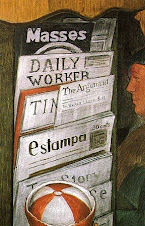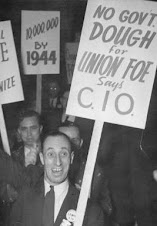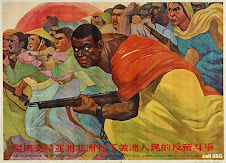
Published Nov 4, 2010 11:26 PM
The following report is based on a talk given by Dante Strobino, a UE150 organizer, at the Oct. 23 Workers World Party Southern Regional Conference in Durham, N.C.
Communists have our roots in North Carolina dating back to the 1920s. The Southern region of the U.S. was of particular importance to the Communist Party because 86 percent of African Americans lived here, and the CP felt Black liberation was a central step towards the overthrow of capitalism inside the U.S. Southern communists have spent many decades working to build unity between Black and white workers. Racism in the U.S. South is a central division that bosses worked hard to maintain in order to keep wages low and unions weak.
Paul Crouch from Moravian Falls, N.C., was in the military in 1924 and joined the Hawaiian Communist League, for which he was jailed for 26 months in Alcatraz. The International Labor Defense League came to his defense, and he emerged from prison the first North Carolina CP member in 1927. After going to the Soviet Union, Crouch toured the South looking for organizing targets in order to build the party.
In December 1928, the Communist-led National Textile Workers Union announced plans to organize N.C. and made Charlotte its headquarters. The Loray Mill strike in 1929 in Gastonia was one of the best-known strikes in U.S. labor history.
The strike at Loray Mill started on Monday, April 1, 1929, after mill supervisors began firing workers who had participated in a union meeting. At that meeting, held the previous Saturday, NTWU organizer and CP member Fred Beal had counted the workers’ votes, which unanimously favored a strike.
Gastonia Mayor Rankin then asked for help from the National Guard, which arrived on April 3. The strike continued to escalate throughout the month. Nearly 100 masked men destroyed the NTWU’s headquarters on April 18, resulting in the NTWU starting a tent city on the outskirts of town that was protected by armed strikers at all times. The strike continued for a few months, but production picked back up.
On June 7, 150 workers marched out to the mill to call out the night shift. This demonstration was attacked and dispersed by sheriff deputies. Police Chief John Aderholt was killed in the scuffle and two officers, as well as a number of strikers, were wounded. Seventy-one strikers were arrested and 16 were indicted for murder. In September, after a mistrial had been called in that case, striker Ella Mae Wiggins was shot and killed while riding to a union rally. Seven men were charged with her murder (six of them employed by the Loray Mill). All were found not guilty.
Through the early 1930s the NCCP and NTWU kept up campaigns to organize workers, the unemployed and African Americans through unionization, electoral campaigns and struggles against legal lynchings. By January 1932, there were 300 party members in N.C. Active branches existed in Winston-Salem, Charlotte, Chapel Hill, Concord and many rural areas.
1940s: Organizing R.J. Reynolds
By 1940 R.J. Reynolds operated the largest tobacco manufacturing facility in the world. Its approximately 12,000 employees (plus several thousand seasonal workers in the city’s independent leaf houses) represented one of the largest concentrations of industrial workers in the region.
Two-thirds of the workers were African-American and more than half were women. Taking advantage of the window of opportunity that opened during World War II, the Food, Tobacco, Agricultural and Allied Workers of America Union, Local 22, won collective bargaining rights at Reynolds and three smaller independent leaf houses in 1943. Local 22 helped spearhead the election of a Black minister to the Winston-Salem Board of Aldermen, the first Black candidate to defeat a white in the South since the turn of the century.
The local’s brand of race-inflected “civic unionism” thus expressed the experience and perspective of its African-American members, who combined class consciousness with race solidarity and looked to cross-class institutions such as the Black church as a key base of support.
Although the company and the union finally reached a settlement on June 7, 1947, it proved to be the last collective bargaining agreement signed by the Reynolds Tobacco Co. Three years later, after a controversial National Labor Relations Board ruling that effectively disenfranchised Black seasonal workers and allowed lower-level white supervisors to vote in a recertification election, Local 22 lost the right to represent Reynolds workers.
In the 1970s there was a major organizing campaign at Duke Hospital in Durham, N.C. The Duke family made their money in tobacco, later expanded into the electric power industry and eventually endowed Duke University. Meanwhile, Howard Fuller and other Durham activists in the mid-1960s had generated a variety of local organizations, such as Malcolm X Liberation University and the Student Organization for Black Unity. When these and other organizations all jelled at a national level into the African Liberation Support Committee in 1972, Durham’s leaders were influential in this national movement. The ALSC had a strong Southern base, but also had action based outside the South.
The Revolutionary Workers League, a national Black communist pre-party formation, had a strong chapter in Durham that grew out of the ALSC through Black Marxist study groups. The white student movement was also moving towards radical and Marxist politics. In Durham in 1972-73 white activists formed two collectives — a health collective and a socialist feminist collective — both affiliated with the communist-oriented New American Movement. In 1973, the health collective became the Durham Organizing Committee. The DOC later split, some members entering a Marxist-Leninist collective and others, critical of a lack of democracy, formed the Durham People’s Alliance.
By 1975, Black activists in RWL and white activists in DOC were moving in parallel, forming a joint study group and a strategy committee to discuss a union drive at Duke Hospital. Both agreed on the importance of unity of Black and white workers and both had members who were worker leaders in the union efforts. Later, DOC became the Communist Workers Party.
BWFJ, UE organize in N.C.
Starting in 1981, Black Workers For Justice, a civil rights, labor and community-based organization, laid the foundation for forming United Electrical (UE) Local 150, the North Carolina Public Service Workers Union. BWFJ had as a cornerstone of its political program the centrality of Black workers. This was a perspective shaped by revolutionaries who worked in the auto plants and other industries with large concentrations of Black workers.
It recognized that trade union consciousness would be narrow and only oriented to the economic issues, and wouldn’t address the structural racism that saw Black workers being victimized by superexploitation at work and denial of real democratic rights in the larger society.
The year 2010 marks the 20th anniversary of the organization of the Consolidated Diesel Co. Workers Unity Committee. Members of BWFJ and other workers collected the signatures of 210 CDC workers demanding a paid holiday for Martin Luther King Jr.’s birthday, again bringing together white and Black workers to overcome racism caused by the bosses. The workers delivered the petitions to CDC management on Jan. 15, 1990.
This began an eight-month campaign for a paid holiday, which was won on Aug. 1, 1990. The CDC Workers Unity Committee then joined with the Bloomer Hill community to host the annual MLK Day celebration, first held in January 1991. This struggle helped attract UE to North Carolina. Short of enough votes to win a National Labor Relations Board union recognition election, the workers began organizing a non-majority union at CDC.
In the mid-1990s, housekeepers at the University of North Carolina formed the UNC Housekeepers Association, which struggled for decent wages and an end to the racism and sexism that kept the workers treated like second-class citizens. In 1997, UE organizers began to help the association develop deeper organizing skills. They held a mass march and eventually a statewide organization of frontline university workers. This statewide struggle led to many victories, including a major policy change that allowed workers to bring a co-worker (union steward) to grievance hearings. In 1999, more than 100 state and city workers, mostly university workers, came together to found UE Local 150, the N.C. Public Service Workers Union.
North Carolina and Virginia are the only two states with laws denying public sector workers the right to collectively bargain. The founding of the union finally gave rank-and-file workers the organizational beginnings necessary to overturn this Jim Crow law, passed in 1959 by an all-white legislature.
In 2001, the state of N.C. launched a mental health reform plan that promised to bring mental health patients quality care through finally enacting measures of the Olmstead Act stating that patients receive higher quality care if they are closer to home. The state’s Department of Health and Human Services used this as a basis to severely downsize all the state’s large psychiatric hospitals and developmental disability centers.
All the county-run beds, which employed more than 20,000 workers, were privatized. Since 2001, state hospitals have cut resident beds by more than 60 percent. This plan wasted more than $400 million by allowing owners of the private facilities to overcharge the state for community services and to accumulate profits while hiring low-wage, often high-school-aged workers to provide services without adequate training or oversight.
UE Local 150 launched the DHHS Dignity campaign to lift up the voices of mental health workers during this crisis. Workers at Cherry Hospital in rural Goldsboro were central to the initial fightback. Local 150 then launched an effort to build statewide strength and began organizing at several other DHHS facilities. One of the state’s four psychiatric hospitals, Dorothea Dix Hospital in Raleigh, has been targeted for closure, but due to the resistance from UE 150 members at Dix Hospital and community allies, the hospital has remained open. However, in December the hospital will be reduced down to just 26 beds, less than a tenth of its 307 beds in 2001.
Workers throughout the DHHS psychiatric hospitals and mental retardation and substance abuse treatment centers are disciplined and often fired for poor job performance and “patient abuse,” but the cause is the awful conditions of their work: understaffing, forced overtime and lack of adequate training. This shows that the system is broken and that the workers are being scapegoated.
Instead of addressing the conditions, one-sided policies like zero tolerance were put in place by the governor. In 2008, UE Local 150 launched a campaign for a Mental Health Workers Bill of Rights. UE 150 members collected thousands of ballots from DHHS workers finding they had “no confidence” in the mental health reform plan and voted “yes” for a Mental Health Workers Bill of Rights.
Members of BWFJ also helped UE 150 plant roots among city workers in Durham, dating back to the 1980s. In 2003-04, UE Local 150 began organizing workers in other municipalities. Then, in September 2006, sick and tired of forced overtime without pay and lack of dignified work conditions, sanitation workers in Raleigh staged a two-day wildcat strike. This forced the resignation of the assistant city manager and the solid waste manager and won many gains for workers, such as an end to forced overtime, the option to be paid overtime, all temporary workers made permanent, along with many write-ups in workers’ files being taken out. UE Local 150 then again reached out to workers in several other cities to build a statewide organization of city workers, which now has active chapters in Charlotte, Chapel Hill, Rocky Mount, Raleigh and Durham.
Articles copyright 1995-2010 Workers World. Verbatim copying and distribution of this entire article is permitted in any medium without royalty provided this notice is preserved.










































No comments:
Post a Comment